spare wheel KIA NIRO 2017 User Guide
[x] Cancel search | Manufacturer: KIA, Model Year: 2017, Model line: NIRO, Model: KIA NIRO 2017Pages: 552, PDF Size: 14.92 MB
Page 468 of 552
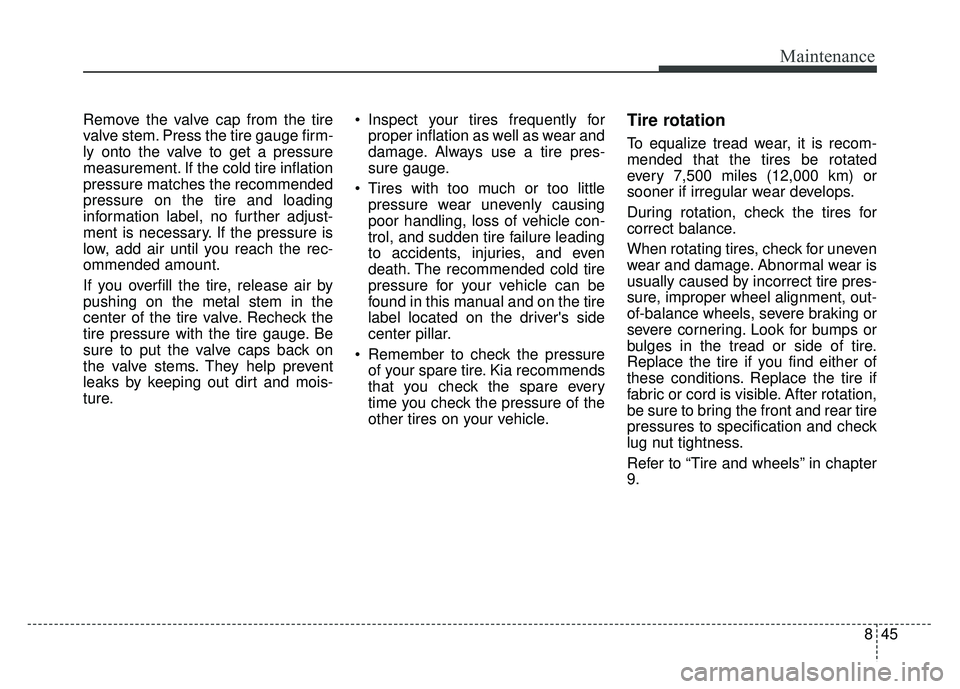
845
Maintenance
Remove the valve cap from the tire
valve stem. Press the tire gauge firm-
ly onto the valve to get a pressure
measurement. If the cold tire inflation
pressure matches the recommended
pressure on the tire and loading
information label, no further adjust-
ment is necessary. If the pressure is
low, add air until you reach the rec-
ommended amount.
If you overfill the tire, release air by
pushing on the metal stem in the
center of the tire valve. Recheck the
tire pressure with the tire gauge. Be
sure to put the valve caps back on
the valve stems. They help prevent
leaks by keeping out dirt and mois-
ture. Inspect your tires frequently for
proper inflation as well as wear and
damage. Always use a tire pres-
sure gauge.
Tires with too much or too little pressure wear unevenly causing
poor handling, loss of vehicle con-
trol, and sudden tire failure leading
to accidents, injuries, and even
death. The recommended cold tire
pressure for your vehicle can be
found in this manual and on the tire
label located on the driver's side
center pillar.
Remember to check the pressure of your spare tire. Kia recommends
that you check the spare every
time you check the pressure of the
other tires on your vehicle.Tire rotation
To equalize tread wear, it is recom-
mended that the tires be rotated
every 7,500 miles (12,000 km) or
sooner if irregular wear develops.
During rotation, check the tires for
correct balance.
When rotating tires, check for uneven
wear and damage. Abnormal wear is
usually caused by incorrect tire pres-
sure, improper wheel alignment, out-
of-balance wheels, severe braking or
severe cornering. Look for bumps or
bulges in the tread or side of tire.
Replace the tire if you find either of
these conditions. Replace the tire if
fabric or cord is visible. After rotation,
be sure to bring the front and rear tire
pressures to specification and check
lug nut tightness.
Refer to “Tire and wheels” in chapter
9.
Page 469 of 552
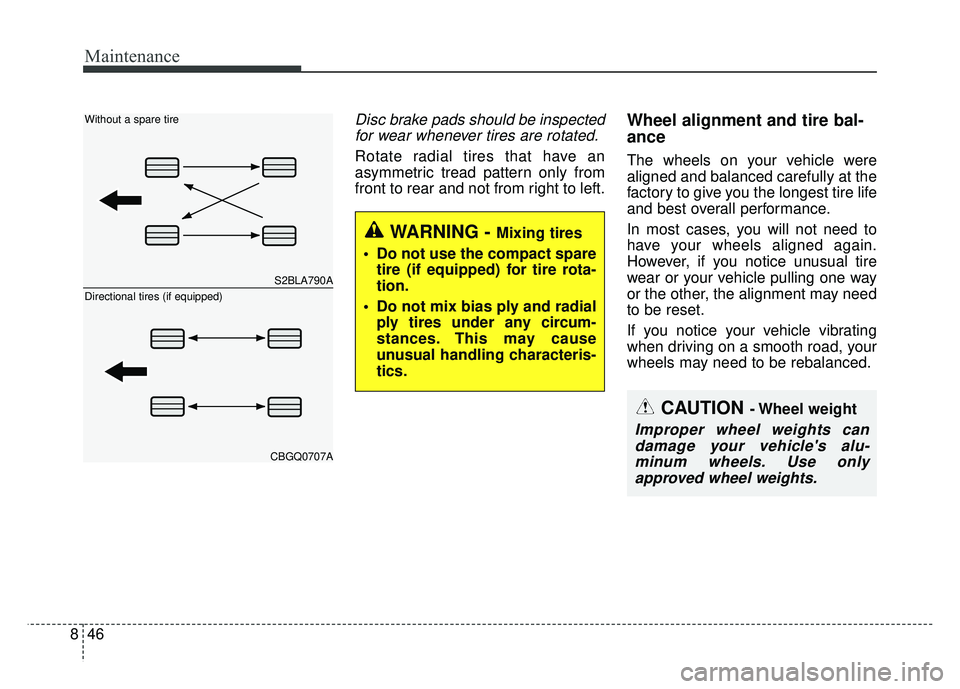
Maintenance
46
8
Disc brake pads should be inspected
for wear whenever tires are rotated.
Rotate radial tires that have an
asymmetric tread pattern only from
front to rear and not from right to left.
Wheel alignment and tire bal-
ance
The wheels on your vehicle were
aligned and balanced carefully at the
factory to give you the longest tire life
and best overall performance.
In most cases, you will not need to
have your wheels aligned again.
However, if you notice unusual tire
wear or your vehicle pulling one way
or the other, the alignment may need
to be reset.
If you notice your vehicle vibrating
when driving on a smooth road, your
wheels may need to be rebalanced.
WARNING - Mixing tires
Do not use the compact spare tire (if equipped) for tire rota-
tion.
Do not mix bias ply and radial ply tires under any circum-
stances. This may cause
unusual handling characteris-
tics.
CAUTION - Wheel weight
Improper wheel weights candamage your vehicle's alu-minum wheels. Use onlyapproved wheel weights.
S2BLA790A
CBGQ0707A
Without a spare tire
Directional tires (if equipped)
Page 473 of 552
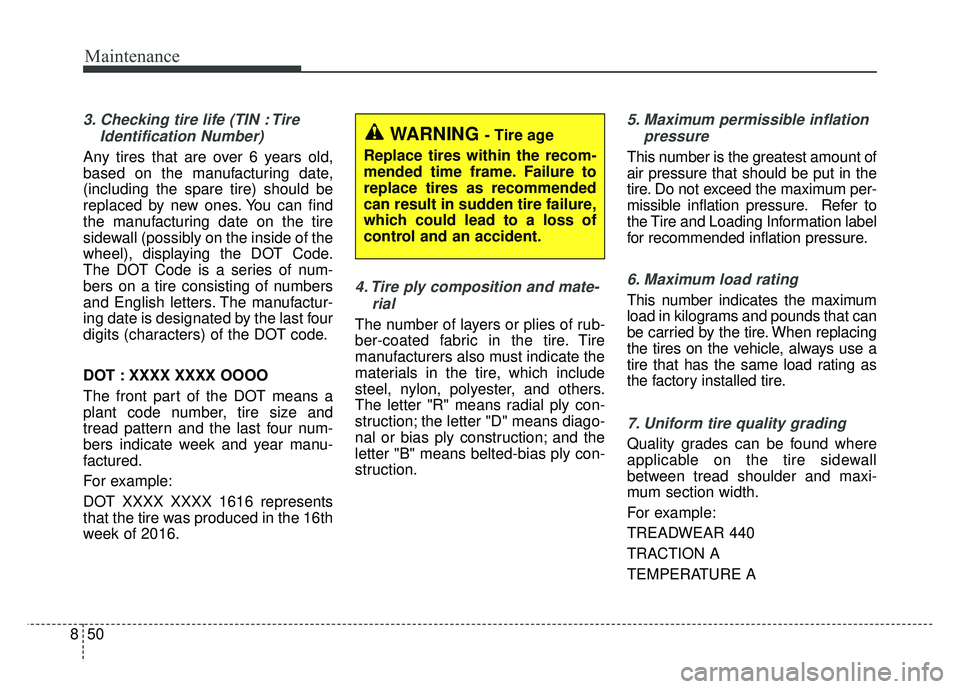
Maintenance
50
8
3. Checking tire life (TIN : Tire
Identification Number)
Any tires that are over 6 years old,
based on the manufacturing date,
(including the spare tire) should be
replaced by new ones. You can find
the manufacturing date on the tire
sidewall (possibly on the inside of the
wheel), displaying the DOT Code.
The DOT Code is a series of num-
bers on a tire consisting of numbers
and English letters. The manufactur-
ing date is designated by the last four
digits (characters) of the DOT code.
DOT : XXXX XXXX OOOO
The front part of the DOT means a
plant code number, tire size and
tread pattern and the last four num-
bers indicate week and year manu-
factured.
For example:
DOT XXXX XXXX 1616 represents
that the tire was produced in the 16th
week of 2016.
4. Tire ply composition and mate-rial
The number of layers or plies of rub-
ber-coated fabric in the tire. Tire
manufacturers also must indicate the
materials in the tire, which include
steel, nylon, polyester, and others.
The letter "R" means radial ply con-
struction; the letter "D" means diago-
nal or bias ply construction; and the
letter "B" means belted-bias ply con-
struction.
5. Maximum permissible inflationpressure
This number is the greatest amount of
air pressure that should be put in the
tire. Do not exceed the maximum per-
missible inflation pressure. Refer to
the Tire and Loading Information label
for recommended inflation pressure.
6. Maximum load rating
This number indicates the maximum
load in kilograms and pounds that can
be carried by the tire. When replacing
the tires on the vehicle, always use a
tire that has the same load rating as
the factory installed tire.
7. Uniform tire quality grading
Quality grades can be found where
applicable on the tire sidewall
between tread shoulder and maxi-
mum section width.
For example:
TREADWEAR 440
TRACTION A
TEMPERATURE A
WARNING - Tire age
Replace tires within the recom-
mended time frame. Failure to
replace tires as recommended
can result in sudden tire failure,
which could lead to a loss of
control and an accident.
Page 526 of 552
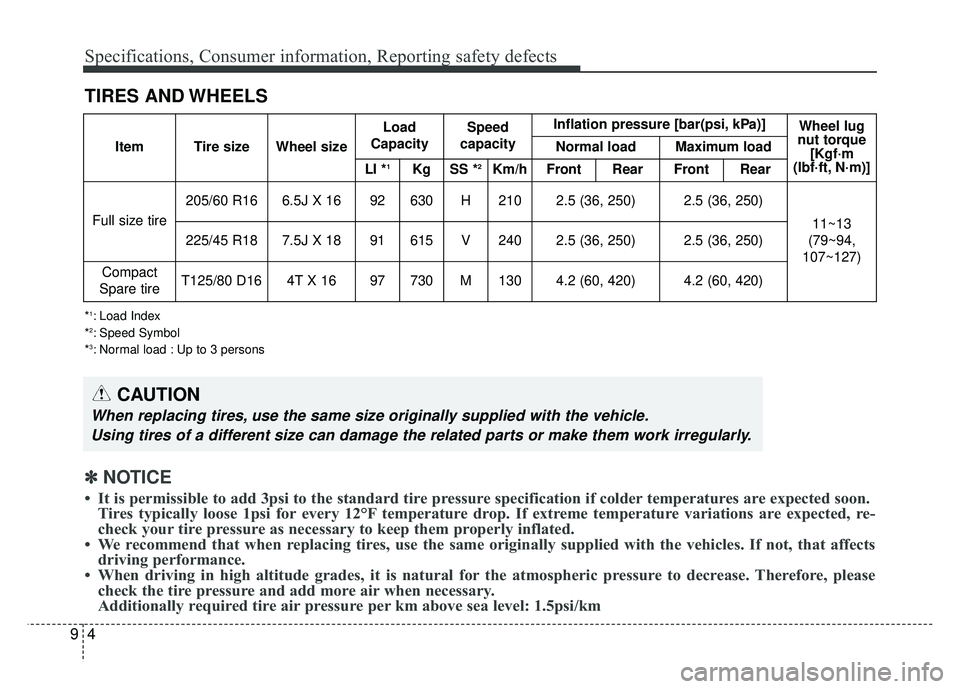
Specifications, Consumer information, Reporting safety defects
49
TIRES AND WHEELS
*1: Load Index
*2: Speed Symbol
*3: Normal load : Up to 3 persons
CAUTION
When replacing tires, use the same size originally supplied with the vehicle. Using tires of a different size can damage the related parts or make them work irregularly.
✽
✽ NOTICE
• It is permissible to add 3psi to the standard tire pressure specification if colder temperatures are expected soon.
Tires typically loose 1psi for every 12°F temperature drop. If extreme temperature variations are expected, re-
check your tire pressure as necessary to keep them properly inflated.
• We recommend that when replacing tires, use the same originally supplied with the vehicles. If not, that aff\
ects driving performance.
• When driving in high altitude grades, it is natural for the atmospheric pressure to decrease. Therefore, please check the tire pressure and add more air when necessary.
Additionally required tire air pressure per km above sea level: 1.5psi/km
ItemTire sizeWheel size
Load
CapacitySpeed
capacityInflation pressure [bar(psi, kPa)]Wheel lug
nut torque [Kgf·m
(lbf·ft, N·m)]
Normal loadMaximum load
LI *1KgSS *2Km/hFront RearFront Rear
Full size tire
205/60 R16 6.5J X 1692630H2102.5 (36, 250)2.5 (36, 250)
11~13
(79~94,
107~127)
225/45 R187.5J X 1891615V2402.5 (36, 250)2.5 (36, 250)
Compact
Spare tireT125/80 D164T X 1697730M1304.2 (60, 420)4.2 (60, 420)
Page 549 of 552
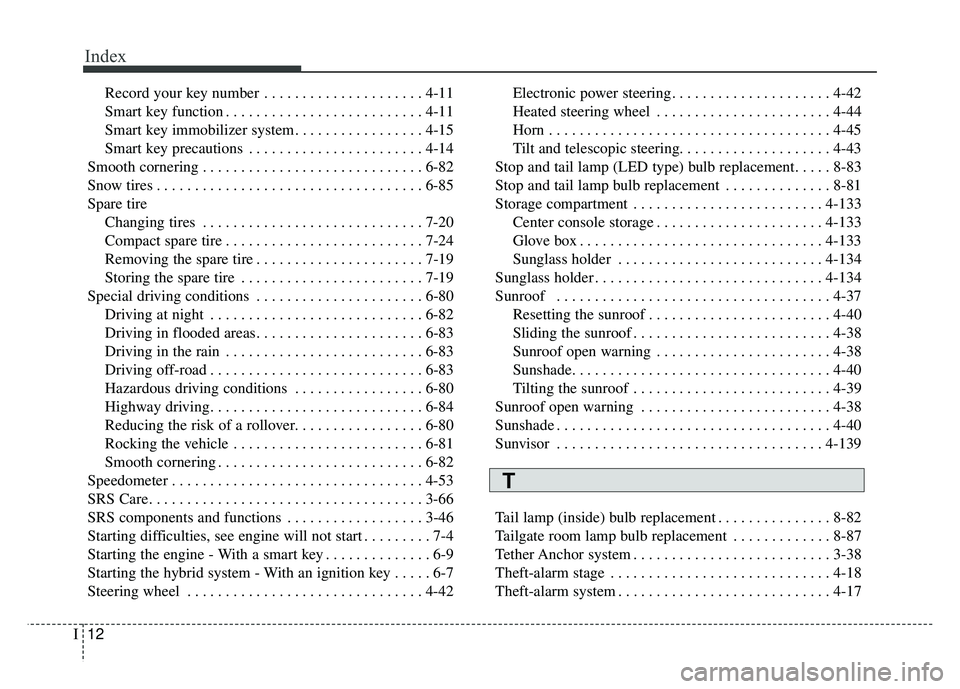
Index
12I
Record your key number . . . . . . . . . . . . . . . . . . . . . 4-11
Smart key function . . . . . . . . . . . . . . . . . . . . . . . . . . 4-11
Smart key immobilizer system. . . . . . . . . . . . . . . . . 4-15
Smart key precautions . . . . . . . . . . . . . . . . . . . . . . . 4-14
Smooth cornering . . . . . . . . . . . . . . . . . . . . . . . . . . . . . 6-82
Snow tires . . . . . . . . . . . . . . . . . . . . . . . . . . . . . . . . . . . 6-\
85
Spare tire Changing tires . . . . . . . . . . . . . . . . . . . . . . . . . . . . . 7-20
Compact spare tire . . . . . . . . . . . . . . . . . . . . . . . . . . 7-24
Removing the spare tire . . . . . . . . . . . . . . . . . . . . . . 7-19
Storing the spare tire . . . . . . . . . . . . . . . . . . . . . . . . 7-19
Special driving conditions . . . . . . . . . . . . . . . . . . . . . . 6-80 Driving at night . . . . . . . . . . . . . . . . . . . . . . . . . . . . 6-82
Driving in flooded areas. . . . . . . . . . . . . . . . . . . . . . 6-83
Driving in the rain . . . . . . . . . . . . . . . . . . . . . . . . . . 6-83
Driving off-road . . . . . . . . . . . . . . . . . . . . . . . . . . . . 6-83
Hazardous driving conditions . . . . . . . . . . . . . . . . . 6-80
Highway driving . . . . . . . . . . . . . . . . . . . . . . . . . . . . 6-84
Reducing the risk of a rollover. . . . . . . . . . . . . . . . . 6-80
Rocking the vehicle . . . . . . . . . . . . . . . . . . . . . . . . . 6-81
Smooth cornering . . . . . . . . . . . . . . . . . . . . . . . . . . . 6-82
Speedometer . . . . . . . . . . . . . . . . . . . . . . . . . . . . . . . . . 4-53
SRS Care. . . . . . . . . . . . . . . . . . . . . . . . . . . . . . . . . . . . \
3-66
SRS components and functions . . . . . . . . . . . . . . . . . . 3-46
Starting difficulties, see engine will not start . . . . . . . . . 7-4
Starting the engine - With a smart key . . . . . . . . . . . . . . 6-9
Starting the hybrid system - With an ignition key . . . . . 6-7
Steering wheel . . . . . . . . . . . . . . . . . . . . . . . . . . . . . . . 4-42 Electronic power steering. . . . . . . . . . . . . . . . . . . . . 4-42
Heated steering wheel . . . . . . . . . . . . . . . . . . . . . . . 4-44
Horn . . . . . . . . . . . . . . . . . . . . . . . . . . . . . . . . . . . . \
. 4-45
Tilt and telescopic steering. . . . . . . . . . . . . . . . . . . . 4-43
Stop and tail lamp (LED type) bulb replacement. . . . . 8-83
Stop and tail lamp bulb replacement . . . . . . . . . . . . . . 8-81
Storage compartment . . . . . . . . . . . . . . . . . . . . . . . . . 4-133 Center console storage . . . . . . . . . . . . . . . . . . . . . . 4-133
Glove box . . . . . . . . . . . . . . . . . . . . . . . . . . . . . . . . 4-133
Sunglass holder . . . . . . . . . . . . . . . . . . . . . . . . . . . 4-134
Sunglass holder . . . . . . . . . . . . . . . . . . . . . . . . . . . . . . 4-134
Sunroof . . . . . . . . . . . . . . . . . . . . . . . . . . . . . . . . . . . . \
4-37 Resetting the sunroof . . . . . . . . . . . . . . . . . . . . . . . . 4-40
Sliding the sunroof . . . . . . . . . . . . . . . . . . . . . . . . . . 4-38
Sunroof open warning . . . . . . . . . . . . . . . . . . . . . . . 4-38
Sunshade. . . . . . . . . . . . . . . . . . . . . . . . . . . . . . . . . . 4-40\
Tilting the sunroof . . . . . . . . . . . . . . . . . . . . . . . . . . 4-39
Sunroof open warning . . . . . . . . . . . . . . . . . . . . . . . . . 4-38
Sunshade . . . . . . . . . . . . . . . . . . . . . . . . . . . . . . . . . . . . \
4-40
Sunvisor . . . . . . . . . . . . . . . . . . . . . . . . . . . . . . . . . . . 4-\
139
Tail lamp (inside) bulb replacement . . . . . . . . . . . . . . . 8-82
Tailgate room lamp bulb replacement . . . . . . . . . . . . . 8-87
Tether Anchor system . . . . . . . . . . . . . . . . . . . . . . . . . . 3-38
Theft-alarm stage . . . . . . . . . . . . . . . . . . . . . . . . . . . . . 4-18
Theft-alarm system . . . . . . . . . . . . . . . . . . . . . . . . . . . . 4-17
T